 Check out the special offers in our August 2014 WebLetter and learn how to qualify for free shipping on orders placed before August 15, 2014.
Check out the special offers in our August 2014 WebLetter and learn how to qualify for free shipping on orders placed before August 15, 2014.
 Check out the special offers in our August 2014 WebLetter and learn how to qualify for free shipping on orders placed before August 15, 2014.
Check out the special offers in our August 2014 WebLetter and learn how to qualify for free shipping on orders placed before August 15, 2014.
By David Heyman
A mat makes any image look more professional. Even without a frame, simply matting your photographs or artwork will do wonders for the presentation, and sales potential, of the work.
Although mats come in many standard sizes, if you are working with custom size images, or anything that is done on a paper that is a creative size, your mat will need to be custom cut. Oak Creek Printworks offers custom cut mats, at a cost relative to a standard size mat, with no extra charges.
How to give the correct measurements for a custom mat is one thing that many artists find confusing. Since custom cut mats are cut to order, it is important to have your borders and window measurements accurate. While you can always call David, our custom picture framer, at (805) 390-4955, with any questions on sizing of borders and windows, the following is a guide that will give you reliable results:
* Add photo of deckle edge watercolor paper, showing w/ ruler how to measure*
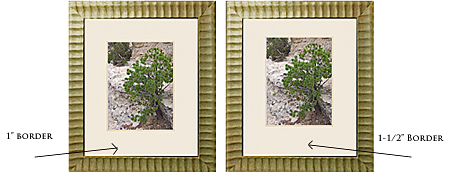
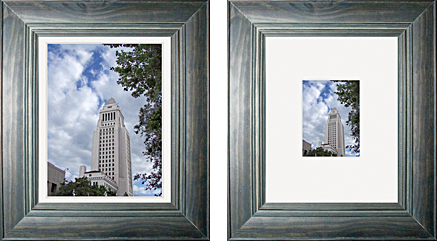
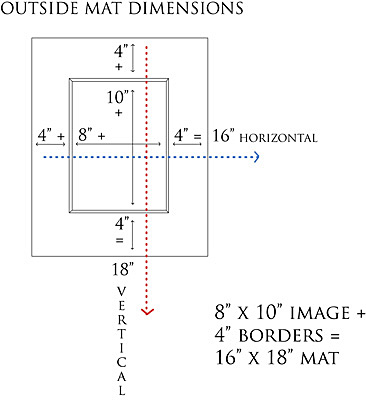
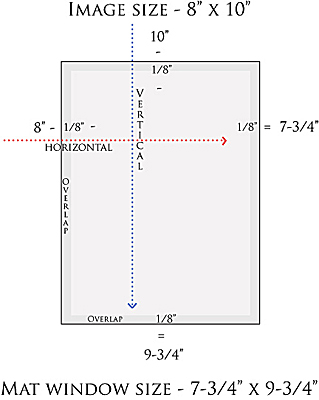
With practice, this process becomes second nature, and can be quickly transformed into a host of eye-catching sizes for all of your pieces. Taking a little time to measure your own custom mats can save you much time when preparing your shows and matted prints. Which will then give you more time to do what you do best – creating!
by David Heyman
The function of a mat is to give breathing space around your artwork or photograph, letting the eye have a place to “rest” while taking in the image. A blank, neutral mat border surrounding the work adds class and transforms what could be a snapshot into a real work of art. Notice the transformation of this image from a plain poster frame, into a professional, gallery quality display, just by the addition of a mat.
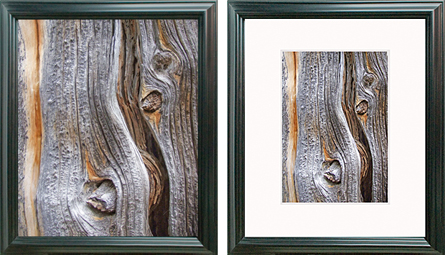
The image on the left looks like a decorative poster, while a mat instantly transforms it into a work of art.
Mats come in many shapes, sizes, colors and textures. However, one crucial element is often overlooked when selecting a mat: whether or not it is archival in quality.
The majority of mats on the market today are made from wood pulp, the same substance used to make mass-produced paper. While paper products made from wood pulp are inexpensive and abundant, their use in displaying and protecting artwork is limited, due to their rapid decay and discoloration.
Wood fiber contains lignin, an acidic substance that is a cellular component of trees. When that fiber is made into paper, including mats, the lignin remains in the finished product, making it a ticking time bomb for eventual disintergration.
Acid causes mats to yellow, staining your artwork in the process. Gone unchecked, a paper mat will eventually turn brown and become brittle, spreading acid burn on to your work. While substances can be added to the paper fibers to slow down the deterioration, they are temporary, and no mat made with wood pulp is suitable for archival use. Look at the effects of a wood pulp mat on this photograph:

Notice the yellowing and discoloration on the image matted with an acidic wood pulp mat.
The finest mats are made with cotton, a fiber that is naturally free from lignin. 100% cotton mats will never yellow, turn brittle or damage your valuable work. Although initially more expensive than the imported mats made with wood pulp, Oak Creek Printworks Bainbridge Alphamats are a good investment, ensuring that your art is protected and will never be ruined by the careless addition of an acidic mat.
When choosing a mat for your work, never settle for “acid-free”. This is a term thrown about so often it has become almost meaningless. Anything can be labeled acid-free, but that doesn’t mean it will last. An acidic wood pulp mat that is sprayed with an akaline coating is called “acid-free”. Yet the acid in the mat will quickly overcome the coating, and it will have worn off even before the mat is used for diplay.
Here are some criteria to use when selecting a fine quality archival mat:
One quick way to check if the mats you have are truly archival – look at the bevel (the slanted cut right next to the window of the mat). Wood pulp mats start out with a yellowish core, which quickly turns brown, as shown in these photos. A cotton mat starts out with a bright white core.
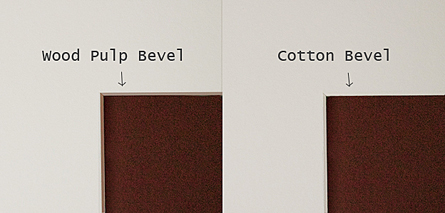
On a wood pulp mat, the bevels start out yellow, then quickly turn brown.
Your artwork is your passion. Never compromise or hurt your images with an acidic mat.
by Georgia Lange
The holiday season is here, and many of us are struggling to find gifts for our loved ones. The solution to this problem is an easy one; the gift of art is priceless. In the past, I have often found myself hesitant to give my art as a holiday gift to a loved one. I was concerned that I was not valuing my own work, or that I was imposing my own sense of taste on someone else. I have come to the conclusion that this is nonsense. The truth is that people love collecting art, and when the art comes directly from you (it is your creation), it is truly special, unique, and personal. What could possibly be more valuable?
Prints make great gifts for anyone who is special to you. You can dress up your prints by matting them and placing each print in a protective plastic sleeve. Trust me; this is a classy gift and can be very cost-effective. Here at Oak Creek Printworks, we offer a package deal that includes the mat, back, and plastic sleeve. Depending on the size of the print, you can keep your costs under $20 per person (which is not easy to do! I usually can’t find great gifts for less than $30 per person, and even then it is difficult!). Ease your holiday headache; give art! You won’t regret it, and it will be a welcome gift to whoever receives it!
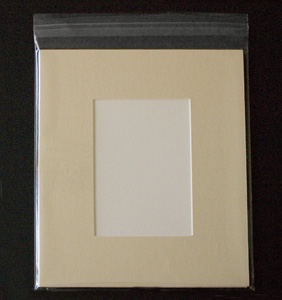
AN ADDITIONAL NOTE: EARNING THE MONEY TO SPEND ON YOUR GIFTS
Over Thanksgiving, I was surprised not only by the abundance of savory dishes that were prepared by friends and family but by the onslaught of inquiries as to how to purchase prints of my work for the sake of holiday gift giving. Remember: you have friends, and your friends have friends. Those friends give and receive gifts too. Since we tend to establish friendships with like-minded individuals, it is not surprising that our friends’ friends often have tastes similar to our own. Your art not only makes a precious gift for you to give, but for others to give too. This is a great opportunity for you to earn the money to spend on your gifts this season, and then some.
Establishing an online presence where people can view and purchase your work is extremely beneficial. Etsy, a site geared towards all things handmade, is a great way to set up your work for sales. Another great site geared towards artists selling their work online is Big Cartel. Check these sites out as soon as possible, and figure out what will work best for you. Then make the necessary phone calls and emails to your friends and acquaintances and let them know what a wonderful gift your art would make for someone they know, and where they can purchase it easily online.
Be kind this holiday season, and let the season be kind to you.